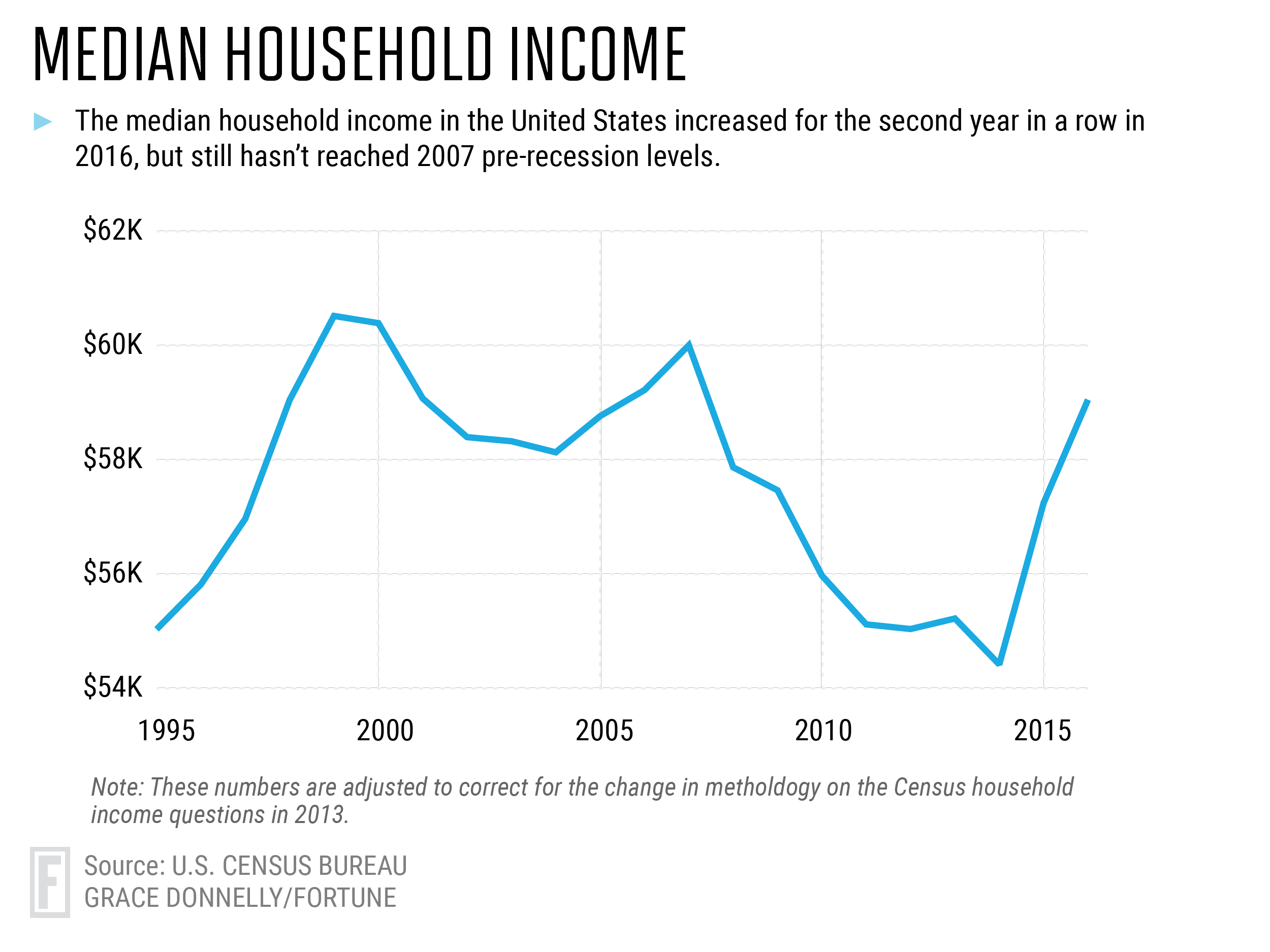最新数据显示,美国人收入并未恢复到金融危机之前的水平
|
美国人口普查局的最新数据,为美国人民带来了一些2016年的好消息:家庭收入上涨,贫困率下降,性别薪酬差距缩小,医疗保健覆盖率扩大。 当然,其中也有一些坏消息。这些数据中的下面三个趋势,可以让我们更全面地了解2016年的报告。 数据喜人,但依旧低于衰退之前的水平 家庭收入连续第二年保持增长,但收入增长速度依旧缓慢。美国人的工资收入并未增加,收入增长的原因来自于就业水平的提高,以及每个家庭有了更多的合并工资收入。 收入水平并未恢复到金融危机之前的水平。经济政策研究所使用人口普查数据计算出的结果显示,去年,美国家庭收入的中位数为59,039美元,低于2007年的中位数59,992美元或2000年的中位数60,399美元。 |
New data from the U.S. Census Bureau showed good news for Americans in 2016: Household income is up, poverty is down, the gender pay gap narrowed, and healthcare coverage expanded. This sunny outlook does come with a few clouds, though. Here are three trends in the data that put 2016 report in context. The numbers are good, but still below pre-recession levels Household income has increased for the second year in a row, but earnings growth is still slow. The wages Americans earn have not increased, rather income gains are being driven by rising employment levels and more combined paychecks in each household. Income levels still haven’t returned to the levels seen before the financial crisis. Last year, median household income in the United States was $59,039 — lower than the $59,992 median in 2007 or the $60,399 median income in 2000 — based on calculations by the Economic Policy Institute using Census data. |

|
经济政策研究所高级经济学家埃丽斯·古尔德表示:“我相信,家庭收入经过再一年强劲增长,我们完全有可能恢复到2007年之前的水平。” 美国生活在贫困当中的人口百分比连续两年下降,但依旧略高于2007年的水平,比2000年高出了1.4个百分点。 非洲裔和拉美裔家庭收入增幅最大 非洲裔和拉美裔家庭连续两年保持了最快的收入增长速度。非洲裔家庭收入增长了5.7%,拉美裔家庭收入增长了4.3%。 亚裔家庭收入增长了4.2%,而非拉美裔白人家庭收入增长了2%。 |
“I fully expect, with another year of strong growth in household income, we will be back to pre-2007 levels,” said Elise Gould, senior economist at EPI. The percentage of Americans living in poverty has fallen for the second year in a row, but is still slightly higher than in 2007 and still 1.4 percentage points higher than in 2000. Black and Latinx households saw the largest gains Income has grown fastest for Black and Latinx households for the second year in a row. Black households saw a 5.7% increase, while Latinx household income grew by 4.3%. Asian households saw a 4.2% increase and non-Hispanic white household income increased by 2%. |

|
这些家庭与白人家庭之间的种族收入差距正在缩小。目前,白人家庭每收入1美元,非洲裔家庭只能收入61美分,拉美裔家庭只能收入73美分,但与2015年的59美分和71美分相比均有所上涨。 虽然2016年的贫困率下降,但非洲裔和拉美裔家庭的贫困率依旧最高。非洲裔美国人的贫困率下降至22%,拉美裔美国人的贫困率下降至19.4%,但远高于12.7%的美国平均贫困率。 高收入与低收入人群收入增长不平衡 家庭收入增长的主要动力来自于就业增长,但多数新增就业都属于低薪岗位。虽然收入增加,但低收入家庭的经济状况并没有迅速恢复。 |
This narrowed the racial income gap between these households and their white counterparts. Black households now earn 61 cents for every dollar in a white household and Latinx households earn 73 cents on the dollar, up from 59 cents and 71 cents, respectively, in 2015. Though poverty rates decreased in 2016, they remain highest for black and latinx households. The poverty rate dropped to 22% for black Americans and 19.4% for Latinx Americans — both significantly higher than the average U.S. poverty rate of 12.7%. The growth is uneven across top and bottom earners The rise in household income is being driven by job growth, but most of this new work is in low-paying positions. While incomes are increasing, lower income households aren't recovering as quickly. |

|
5%高收入人群的收入增长最快,中位数收入比经济衰退之前的水平提高了8.7%。收入排在后5%的人群,尚未达到经济衰退之前的收入水平。该部分人口的收入较经济衰退之前的收入水平依旧低了2.7%。 经济政策研究所的经济学家们表示,再来一年的名义收入增长,应该可以使中间5%人口的收入恢复到2007年的水平。(财富中文网) 译者:刘进龙/汪皓 |
The top 5% of earners are seeing their income grow the fastest, with median incomes 8.7% higher than pre-recession levels. The bottom fifth of the population has yet to reach pre-recession levels. Incomes for this segment of the population remain 2.7% below pre-recession incomes. The EPI economists say one more year of normal income growth should restore incomes in the middle-fifth to their 2007 levels. |













